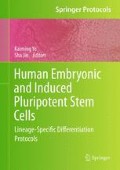Abstract
The hallmark of pluripotent stem cells is their nearly unlimited self-renewal capacity, and their potential to differentiate into a diverse range of specialized cell types. These unique properties make stem cells important research tools, in vitro models for pharmaceutical testing, and an attractive source of various cell types for regenerative therapies. For stem cell technology to be fully exploited, however, culture systems must be improved to enable large-scale production, and safety ensured. Most stem cell culture systems developed to date utilize undefined, xenogeneic products that pose a risk of a severe immune response and the transmission of infections. In this chapter, we describe a robust method for the expansion of pluripotent stem cells in defined and xeno-free culture conditions. Both mechanical and single-cell enzymatic passaging can be applied with this method. This procedure can be adopted for both basic research purposes and clinical applications.
Access this chapter
Tax calculation will be finalised at checkout
Purchases are for personal use only
References
Peerani, R., Rao, B.M., Bauwens, C., Yin, T., Wood, G.A., Nagy, A., Kumacheva, E., Zandstra, P.W. (2007) Niche-mediated control of human embryonic stem cell self-renewal and differentiation. EMBO J 26, 4744–4755.
Thomson, J., Itskovitz-Eldor, J., Shapiro, S., Waknitz, M., Swiergiel, J., Marshall, V., Jones, J. (1998) Embryonic stem cell lines derived from human blastocysts Science 282, 1145–7.
Skottman, H., Stromberg, A.M., Matilainen, E., Inzunza, J., Hovatta, O., Lahesmaa, R. (2006) Unique gene expression signature by human embryonic stem cells cultured under serum-free conditions correlates with their enhanced and prolonged growth in an undifferentiated stage. Stem Cells 24, 151–67.
Bradley, J.A., Bolton, E.M., Pedersen, R.A. (2002) Stem cell medicine encounters the immune system. Nat Rev Immunol 2, 859–71.
Selvaggi, T.A., Walker, R.E., Fleisher, T.A. (1997) Development of antibodies to fetal calf serum with arthus-like reactions in human immunodeficiency virus-infected patients given syngeneic lymphocyte infusions. Blood 89, 776–9.
Martin, M., Muotri, A., Gage, F., Varki, A. (2005) Human embryonic stem cells express an immunogenic nonhuman sialic acid. Nat med 11, 228–232.
Heiskanen, A., Satomaa, T., Tiitinen, S., Laitinen, A., Mannelin, S., Impola, U., Mikkola, M., Olsson, C., Miller-Podraza, H., Blomqvist, M., Olonen, A., Salo, H., Lehenkari, P., Tuuri, T., Otonkoski, T., Natunen, J., Saarinen, J., Laine, J. (2007) N-glycolylneuraminic acid xenoantigen contamination of human embryonic and mesenchymal stem cells is substantially reversible. Stem Cells 25, 197–202.
Sakamoto, N., Tsuji, K., Muul, L.M., Lawler, A.M., Petricoin, E.F., Candotti, F., Metcalf, J.A., Tavel, J.A., Lane, H.C., Urba, W.J., Fox, B.A., Varki, A., Lunney, J.K., Rosenberg, A.S. (2007) Bovine apolipoprotein B-100 is a dominant immunogen in therapeutic cell populations cultured in fetal calf serum in mice and humans. Blood 110, 501–508.
Hisamatsu-Sakamoto, M., Sakamoto, N., Rosenberg, A.S. (2008) Embryonic stem cells cultured in serum-free medium acquire bovine apolipoprotein B-100 from feeder cell layers and serum replacement medium. Stem Cells 26, 72–8.
Cobo F, Stacey G, Hunt C, Cabrera C, Nieto A, Montes R, Cortes J, Catalina P, Barnie A, Concha A (2005): Microbiological control in stem cell banks: approaches to standardisation. Appl Microbiol Biotechnol 68, 456–66.
Rajala, K., Lindroos, B., Hussein, S.M., Lappalainen, R.S., Pekkanen-Mattila, M., Inzunza, J., Rozell, B., Miettinen, S., Narkilahti, S., Kerkelä, E., Aalto-Setälä, K., Otonkoski, T., Suuronen, R., Hovatta, O., Skottman, H. (2010) A Defined and Xeno-free Culture Method Enabling the Establishment of Clinical-grade Human Embryonic, Induced Pluripotent and Adipose Stem Cells. Plos One 5, e10246.
Ellerström, C., Strehl, R., Noaksson, K., Hyllner, J., Semb, H. (2007) Facilitated expansion of human embryonic stem cells by single-cell enzymatic dissociation. Stem Cells 25, 1690–6.
Hovatta, O., Mikkola, M., Gertow, M., Stromberg, A., Inzunza, J., Hreinsson, J., Rozell, B., Blennow, E., Andang, M., Ahrlund-Richter, L.(2003) A culture system using human foreskin fibroblasts as feeder cells allows production of human embryonic stem cells. Hum Reprod 18, 1404–1409.
Amit, M., Margulets, V., Segev, H., Shariki, K., Laevsky, I., Coleman, R., Itskovitz-Eldor, J. (2003) Human feeder layers for human embryonic stem cells. Biol Reprod 68, 2150–2156.
Prasad, S., Czepiel, M., Cetinkaya, C., Smigielska, K., Weli, S., Lysdahl, H., Gabrielsen, A., Petersen, K., Ehlers, N., Fink, T., Minger, S., Zachar, V. (2009) Continuous hypoxic culturing maintains activation of Notch and allows long-term propagation of human embryonic stem cells without spontaneous differentiation. Cell Prolif 1, 63–74.
Westfall, S., Sachdev, S., Das, P., Hearne, L., Hannink, M., Roberts, R., Ezashi, T. (2008) Identification of oxygen-sensitive transcriptional programs in human embryonic stem cells. Stem cells dev 5, 869–881.
Author information
Authors and Affiliations
Corresponding author
Editor information
Editors and Affiliations
Rights and permissions
Copyright information
© 2011 Humana Press
About this protocol
Cite this protocol
Rajala, K. (2011). Expansion of Pluripotent Stem Cells in Defined, Xeno-Free Culture System. In: Ye, K., Jin, S. (eds) Human Embryonic and Induced Pluripotent Stem Cells. Springer Protocols Handbooks. Humana Press. https://doi.org/10.1007/978-1-61779-267-0_6
Download citation
DOI: https://doi.org/10.1007/978-1-61779-267-0_6
Published:
Publisher Name: Humana Press
Print ISBN: 978-1-61779-266-3
Online ISBN: 978-1-61779-267-0
eBook Packages: Springer Protocols

